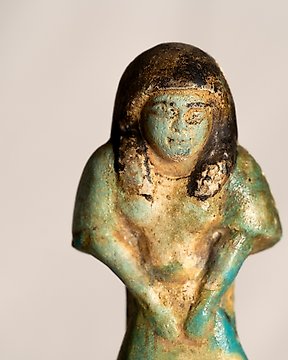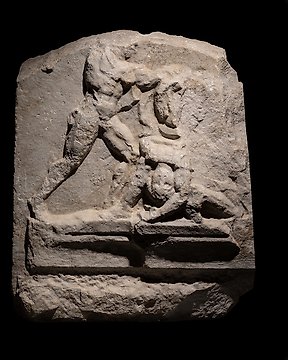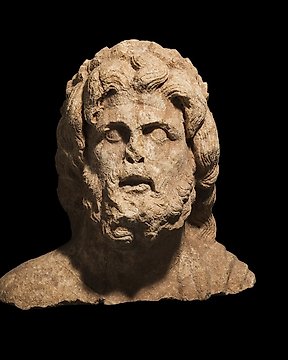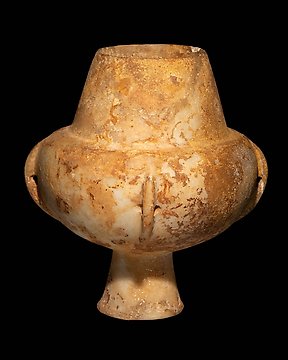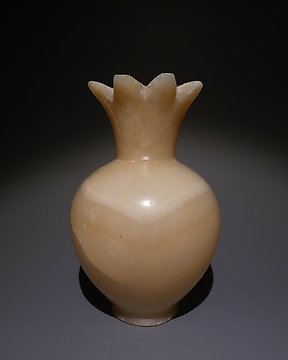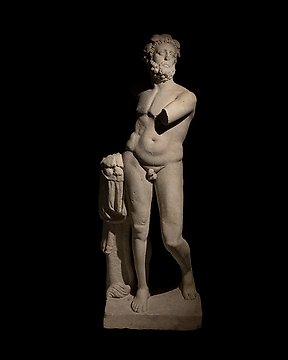All OK and with very fast shipping.
Übersetzung ansehenAltägyptisch Granit Wichtiger Skulpturensockel für den Meister Horiraa. 26. Dynastie, 664-525 v. Chr. 44 cm groß. Sehr - 27×27×44 cm
Nr. 84870847
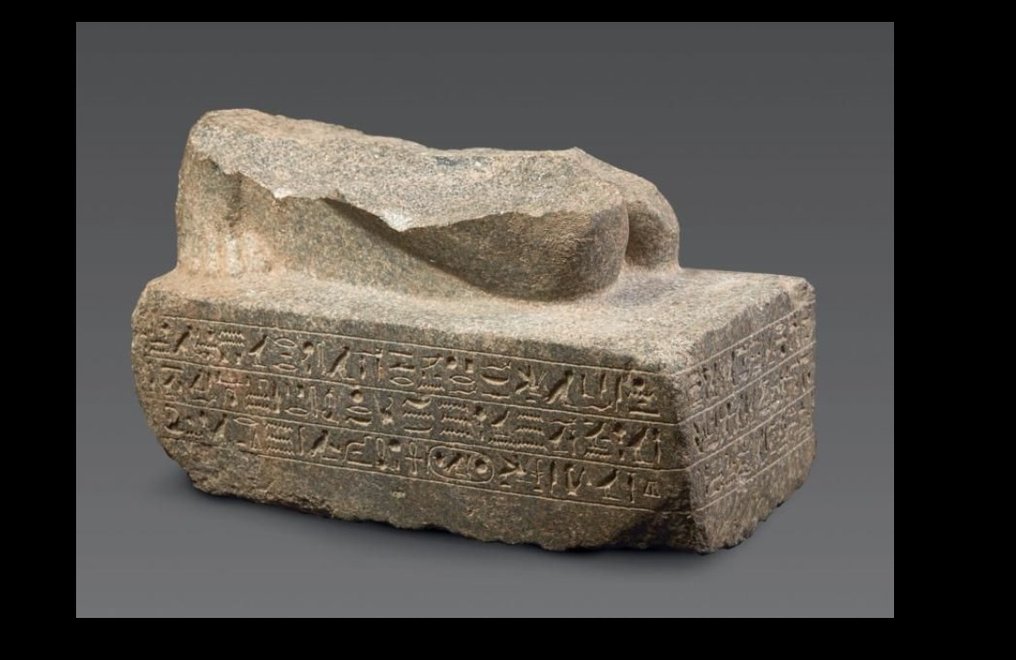


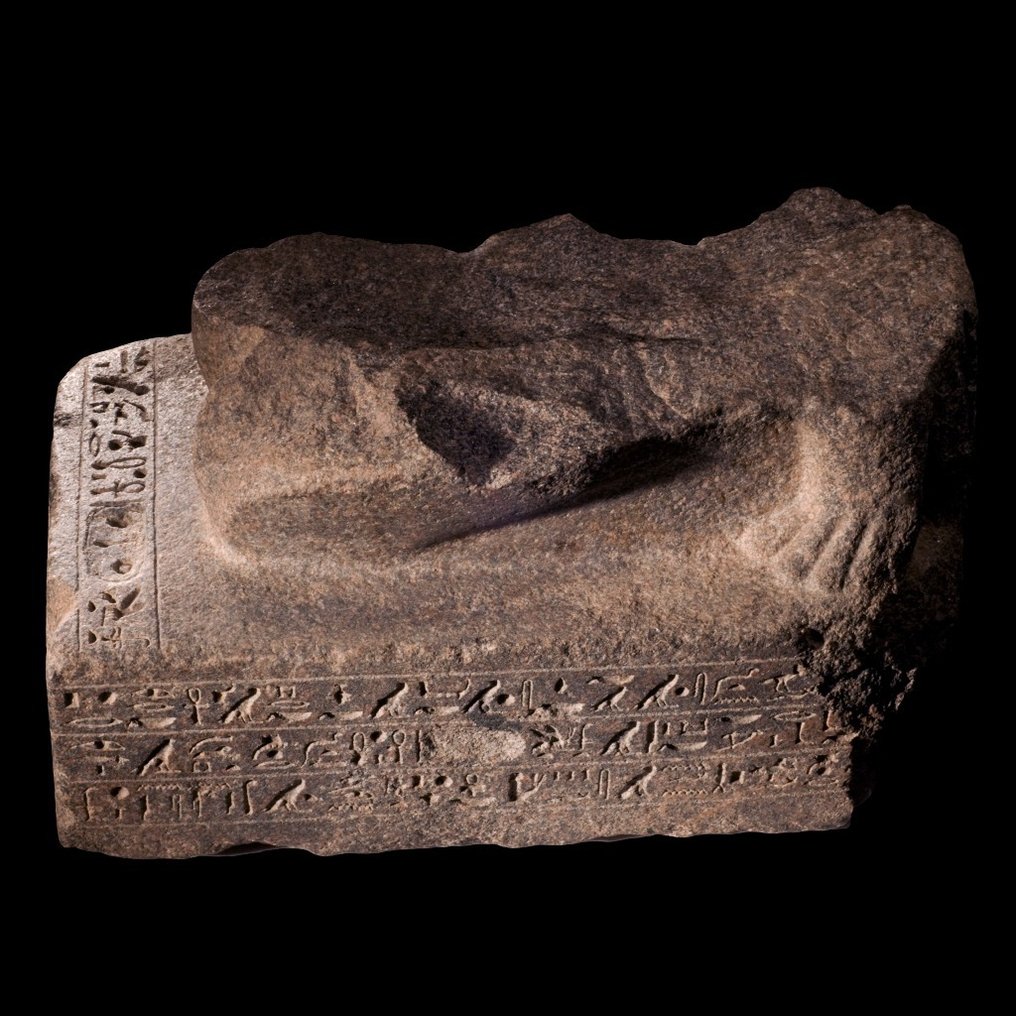

Base of a sculpture belonging to the master Horiraa, royal tutor of the sons of pharaoh Necho II and Psamtik II.
- very important statue -
- museum piece -
Horiraa, was an eminent figure in the royal court. He distinguished himself as the tutor of the sons of (Nekau, Neku) Necho II, and therefore was the tutor of the following pharaoh, Psamtik II.
As a reward for services rendered to the royal family, he obtained during the reign of Apries (the successor of Psamtik II) the possibility to be buried with a quantity of funerary goods fitting a king. His tomb was found in the Memphis necropolis at Saqqara (LS23) comprising two chambers accessible through a shaft.
Ancient Egypt, Second half of Dynasty XXVI, 664-525 BC
Granite
DIMENSIONS: Length 44 cm; width 27 cm; height 27 cm
PROVENANCE: Private collection of H.C., Switzerland. Acquired in 1983.
CONDITION: Very good state, Without restoration. The body of the sculpture has broken away and only the base remains. The hieroglyphic writing on this is, however, in a good state of preservation.
DESCRIPTION:
The lower fragment of a granite sculpture of a high-ranking person in Egyptian society on a rectangular base. Thanks to the conservation of this lower part we can infer what the pose was: the person would have been kneeling with his knees touching the ground, the feet behind balancing on the toes, the back held straight, the gaze to the front and the arms straight by the sides most probably holding a temple or naos on his lap. This typology of sculpture is called a naophoros (temple-bearer) a classical archetype of the effigies of the nobles who consecrate sculptures in their name in order to gain favour with the gods. These naophoros appeared in the New Kingdom, in Dynasty XIX, but their use was generalised in the Ptolemaic Period. Many examples can be found in various museums, one of the most beautiful is the naophoros of Uah-ib-Ra Mery-Neith conserved in the Museum of Archaeology of Naples, in Italy.
Carving of registers of hieroglyphics occupies the space on the base (and even in some cases, part of the surface of the figure). On this piece the sculptor placed the inscriptions in three horizontal registers on the sides and front of the base, another register on the upper surface and another three horizontal ones on the dorsal pillar.
This text has been studied and translated by the French Egyptologist Olivier Perdu:
UPPER PART AND ALONG THE BASE:
“The host near the king of the Upper and Lower Egypt Neferib living as Ra, the Director of the Antechamber Horiraa, says:
Oh my Lord, how happy is he who has your love, and how it fills the heart of your servant! Dignity has been given to me that is, to your Ka. You make me grow among your subjects. The heart of the king is satisfied with what I have done; he sees me as the only one loving his master, suitable to open his heart. I welcome his heart in all its splendour and he distributes my affection throughout the earth. My nature is good; I am always happy, as is my heart; it never reveals itself against them, the courtiers praise my calm. Standing before your stele, I have asked you to put an end to me so that I may reach my grave, he who has no sins, is just (like god) and is likeable. With the favours of my king, the King of Upper and Lower Egypt Wehemibre living eternally like Ra.
Be conscious of what I request of you, all the priests who pass (…..) their, soul, saying: That you may have your bread, that you may have your beer, that you may appear as Ba alive, that you may have (any) transformation (that you wish for), (is) a guest near the King of Upper and Lower Egypt (Wehemibre) living eternally as Ra that the director of the antechamber Horiraa. (As I am) a guest near his master, who employed him for his children.
(Oh) all errands which have been sealed and which travel on my way, as far as I have performed, you realise that I have been given back my reward. So venerate me!
DORSAL BASE:
“(An offering which the king concedes to … that an offering is awarded) invocation- bread, beer, cattle, fowl, pieces of alabaster, incense and oils – (any) thing (…for the Ka of the governor, the bearer of the seal of the King of Upper and Lower Egypt, only friend (…) confidential matters associated with the two uraeus and the director of the antechamber”.
This noble, Horiraa, was an eminent figure in the royal court. He distinguished himself as the tutor of the sons of (Nekau, Neku) Necho II, and therefore was the tutor of the following pharaoh, Psamtik II. As a reward for services rendered to the royal family, he obtained during the reign of Apries (the successor of Psamtik II) the possibility to be buried with a quantity of funerary goods fitting a king. His tomb was found in the Memphis necropolis at Saqqara (LS23) comprising two chambers accessible through a shaft.
The importance of this piece in question lies in the information it supplies, and the fact that it can be attributed to an important courtier in the Nile kingdoms. Eight sculptures are in existence which were made in his honour. These are:
- Naophoros faience sculpture conserved in the Museum of Cairo (CG 807).
- The lower section of a naophoros sculpture conserved in the Museum of Cairo (CG 658).
- Lower part of a naophoros sculpture conserved in the Museum of Cairo (N 9107).
- A bronze group conserved in the Louvre Museum (AF 1670).
- A base, Stockholm NME 43.
- Three sculptures which are privately owned
However, in the Louvre Museum in Paris the table of offerings (D65) can also be found with the set of four canopic vases (N 2968, N 2969, N 2972 y N2974). In the Staatliche Museen in Berlin one of his ushebtis is also conserved. This selection of objects referring to the same owner seldom occurs. It is a luxury to be able to fill out the history of private persons of whom we hardly ever have more details than some names and the positions they occupied.
BIBLIOGRAPHY:
- ABDALAAL, Aisha M. A Granite Statue of Hr-ir-aa (Cairo N 9107). BIFAO 110. Bulletin de l’Institut Français d’Archéologie Orientale. Cairo. 2010. pp. 1 – 11.
- PERDU, Olivier. Le crépuscule des Pharaons. Chefs-d'oeuvre des dernières dynasties édyptiennes. Musée Jacquemart-André. 2012. pp. 124, 144, 148.
Notes:
The seller guarantees that he acquired this piece according to all national and international laws related to the ownership of cultural property. Provenance statement seen by Catawiki.
The seller will take care that any necessary permits, like an export license will be arranged, he will inform the buyer about the status of it if this takes more than a few days.
The piece includes authenticity certificate.
The piece includes Spanish Export License (Passport for European Union) - If the piece is destined outside the European Union a substitution of the export permit should be requested.
Der Verkäufer stellt sich vor
Base of a sculpture belonging to the master Horiraa, royal tutor of the sons of pharaoh Necho II and Psamtik II.
- very important statue -
- museum piece -
Horiraa, was an eminent figure in the royal court. He distinguished himself as the tutor of the sons of (Nekau, Neku) Necho II, and therefore was the tutor of the following pharaoh, Psamtik II.
As a reward for services rendered to the royal family, he obtained during the reign of Apries (the successor of Psamtik II) the possibility to be buried with a quantity of funerary goods fitting a king. His tomb was found in the Memphis necropolis at Saqqara (LS23) comprising two chambers accessible through a shaft.
Ancient Egypt, Second half of Dynasty XXVI, 664-525 BC
Granite
DIMENSIONS: Length 44 cm; width 27 cm; height 27 cm
PROVENANCE: Private collection of H.C., Switzerland. Acquired in 1983.
CONDITION: Very good state, Without restoration. The body of the sculpture has broken away and only the base remains. The hieroglyphic writing on this is, however, in a good state of preservation.
DESCRIPTION:
The lower fragment of a granite sculpture of a high-ranking person in Egyptian society on a rectangular base. Thanks to the conservation of this lower part we can infer what the pose was: the person would have been kneeling with his knees touching the ground, the feet behind balancing on the toes, the back held straight, the gaze to the front and the arms straight by the sides most probably holding a temple or naos on his lap. This typology of sculpture is called a naophoros (temple-bearer) a classical archetype of the effigies of the nobles who consecrate sculptures in their name in order to gain favour with the gods. These naophoros appeared in the New Kingdom, in Dynasty XIX, but their use was generalised in the Ptolemaic Period. Many examples can be found in various museums, one of the most beautiful is the naophoros of Uah-ib-Ra Mery-Neith conserved in the Museum of Archaeology of Naples, in Italy.
Carving of registers of hieroglyphics occupies the space on the base (and even in some cases, part of the surface of the figure). On this piece the sculptor placed the inscriptions in three horizontal registers on the sides and front of the base, another register on the upper surface and another three horizontal ones on the dorsal pillar.
This text has been studied and translated by the French Egyptologist Olivier Perdu:
UPPER PART AND ALONG THE BASE:
“The host near the king of the Upper and Lower Egypt Neferib living as Ra, the Director of the Antechamber Horiraa, says:
Oh my Lord, how happy is he who has your love, and how it fills the heart of your servant! Dignity has been given to me that is, to your Ka. You make me grow among your subjects. The heart of the king is satisfied with what I have done; he sees me as the only one loving his master, suitable to open his heart. I welcome his heart in all its splendour and he distributes my affection throughout the earth. My nature is good; I am always happy, as is my heart; it never reveals itself against them, the courtiers praise my calm. Standing before your stele, I have asked you to put an end to me so that I may reach my grave, he who has no sins, is just (like god) and is likeable. With the favours of my king, the King of Upper and Lower Egypt Wehemibre living eternally like Ra.
Be conscious of what I request of you, all the priests who pass (…..) their, soul, saying: That you may have your bread, that you may have your beer, that you may appear as Ba alive, that you may have (any) transformation (that you wish for), (is) a guest near the King of Upper and Lower Egypt (Wehemibre) living eternally as Ra that the director of the antechamber Horiraa. (As I am) a guest near his master, who employed him for his children.
(Oh) all errands which have been sealed and which travel on my way, as far as I have performed, you realise that I have been given back my reward. So venerate me!
DORSAL BASE:
“(An offering which the king concedes to … that an offering is awarded) invocation- bread, beer, cattle, fowl, pieces of alabaster, incense and oils – (any) thing (…for the Ka of the governor, the bearer of the seal of the King of Upper and Lower Egypt, only friend (…) confidential matters associated with the two uraeus and the director of the antechamber”.
This noble, Horiraa, was an eminent figure in the royal court. He distinguished himself as the tutor of the sons of (Nekau, Neku) Necho II, and therefore was the tutor of the following pharaoh, Psamtik II. As a reward for services rendered to the royal family, he obtained during the reign of Apries (the successor of Psamtik II) the possibility to be buried with a quantity of funerary goods fitting a king. His tomb was found in the Memphis necropolis at Saqqara (LS23) comprising two chambers accessible through a shaft.
The importance of this piece in question lies in the information it supplies, and the fact that it can be attributed to an important courtier in the Nile kingdoms. Eight sculptures are in existence which were made in his honour. These are:
- Naophoros faience sculpture conserved in the Museum of Cairo (CG 807).
- The lower section of a naophoros sculpture conserved in the Museum of Cairo (CG 658).
- Lower part of a naophoros sculpture conserved in the Museum of Cairo (N 9107).
- A bronze group conserved in the Louvre Museum (AF 1670).
- A base, Stockholm NME 43.
- Three sculptures which are privately owned
However, in the Louvre Museum in Paris the table of offerings (D65) can also be found with the set of four canopic vases (N 2968, N 2969, N 2972 y N2974). In the Staatliche Museen in Berlin one of his ushebtis is also conserved. This selection of objects referring to the same owner seldom occurs. It is a luxury to be able to fill out the history of private persons of whom we hardly ever have more details than some names and the positions they occupied.
BIBLIOGRAPHY:
- ABDALAAL, Aisha M. A Granite Statue of Hr-ir-aa (Cairo N 9107). BIFAO 110. Bulletin de l’Institut Français d’Archéologie Orientale. Cairo. 2010. pp. 1 – 11.
- PERDU, Olivier. Le crépuscule des Pharaons. Chefs-d'oeuvre des dernières dynasties édyptiennes. Musée Jacquemart-André. 2012. pp. 124, 144, 148.
Notes:
The seller guarantees that he acquired this piece according to all national and international laws related to the ownership of cultural property. Provenance statement seen by Catawiki.
The seller will take care that any necessary permits, like an export license will be arranged, he will inform the buyer about the status of it if this takes more than a few days.
The piece includes authenticity certificate.
The piece includes Spanish Export License (Passport for European Union) - If the piece is destined outside the European Union a substitution of the export permit should be requested.
Der Verkäufer stellt sich vor
- 754
- 6
- 0
Prachtig schilderij. Zo blij mee. Zeer nette verkoper en zeer snelle levering.
Übersetzung ansehenperfect ! very fast and high quality delivery !
Übersetzung ansehenAll well! Thanks.
Übersetzung ansehenVendeur très professionnel, top +++×
Übersetzung ansehenPhotos trop contrastées pour bien percevoir les défauts, mais ces défauts étaient visibles pour autant. Le "Bon état" est trompeur. Sinon, envoi rapide et correctement emballé. Frais de port exagérés.
Übersetzung ansehenGreat communication, delivery and product. Came with a well made certificate of authenticity and good packaging. Overall very happy with the purchase! Delivery is a bit expensive, but I recommend it
Übersetzung ansehenMagnifique témoin du passé, envoyé avec tous les justificatifs, impeccable. Encore une fois très satisfait, un grand merci
Übersetzung ansehenThank you for the Special offer and the fast shipping of this excellent piece of art!
Übersetzung ansehenvery good description of the object, very good price for this rare item,. Fast sending (has been at my place 2 days after buying!). Definitely would buy again.
Übersetzung ansehenSehr schön
Übersetzung ansehenAs described, perfect logistic
Übersetzung ansehengreat seller, everything came as should with certificate of authenticity
Übersetzung ansehenExceptionally well packaged, description aligned with positing received
Übersetzung ansehenReally precious, but without sound...
Übersetzung ansehenPainting well packed and rapidly sent!
Übersetzung ansehensempre grande rapidità e professionalità
Übersetzung ansehenparfait bien reçu, merci
Übersetzung ansehenVery satisfied with the small Greek Lekythos. As always (we have already bought several items from Bagot), the object was wrapped and sent immediately and with the greatest care.
Übersetzung ansehenPerfect, excellent condition, good packaging, the parcel arrived without any problems… all is perfect as usual. Thank you very much and wait for an other nice piece like this one. Gilles.
Übersetzung ansehen+++ Top vendeur professionnel comme d'habitude
Übersetzung ansehenEmbora o custo de transporte esteja acima da média foi, realmente, muito bem executado e em embalagem cuidada. Expeditos e profissionais. Recomendo
Übersetzung ansehenSnel en correct en goed verpakt verzonden
Übersetzung ansehenoggetto bellissimo, fedele alla descrizione, venditore affidabile
Übersetzung ansehenVery nice piece and fast delivery
Übersetzung ansehen- 754
- 6
- 0
All OK and with very fast shipping.
Übersetzung ansehenDisclaimer
Der Verkäufer garantiert und kann belegen, dass das Objekt legal erworben wurde. Der Verkäufer wurde von Catawiki darüber informiert, dass er die Unterlagen, die gemäß den Gesetzen und Vorschriften seines Landes erforderlich sind, zur Verfügung stellen muss. Der Verkäufer garantiert, dass er berechtigt ist, das Objekt zu verkaufen/auszuführen. Der Verkäufer wird dem Käufer alle Informationen, die zur Provenienz des Objekts vorliegen, zur Verfügung stellen. Der Verkäufer versichert, dass alle erforderlichen Genehmigungen eingeholt wurden/werden. Der Verkäufer wird den Käufer unverzüglich über etwaige Verzögerungen bei der Einholung dieser Genehmigungen informieren.
Der Verkäufer garantiert und kann belegen, dass das Objekt legal erworben wurde. Der Verkäufer wurde von Catawiki darüber informiert, dass er die Unterlagen, die gemäß den Gesetzen und Vorschriften seines Landes erforderlich sind, zur Verfügung stellen muss. Der Verkäufer garantiert, dass er berechtigt ist, das Objekt zu verkaufen/auszuführen. Der Verkäufer wird dem Käufer alle Informationen, die zur Provenienz des Objekts vorliegen, zur Verfügung stellen. Der Verkäufer versichert, dass alle erforderlichen Genehmigungen eingeholt wurden/werden. Der Verkäufer wird den Käufer unverzüglich über etwaige Verzögerungen bei der Einholung dieser Genehmigungen informieren.




